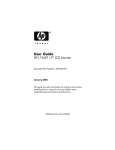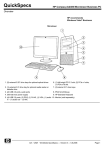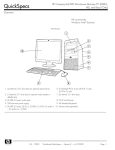Download HP L919g User's Manual
Transcript
User Guide HP L717g 17” and HP L919g 19” Flat Panel Monitors Document Part Number: 395552-001 May 2005 This guide provides information on setting up the monitor, installing drivers, using the on-screen display menu, troubleshooting and technical specifications. Enhanced for Accessibility © 2005 Hewlett-Packard Development Company, L.P. HP, Hewlett Packard, and the Hewlett-Packard logo are trademarks of Hewlett-Packard Company in the U.S. and other countries. Compaq and the Compaq logo are trademarks of Hewlett-Packard Development Company, L.P. in the U.S. and other countries. Microsoft, Windows, and the Windows logo are trademarks of Microsoft Corporation in the U.S. and other countries. All other product names mentioned herein may be trademarks of their respective companies. Hewlett-Packard Company shall not be liable for technical or editorial errors or omissions contained herein or for incidental or consequential damages in connection with the furnishing, performance, or use of this material. The information in this document is provided “as is” without warranty of any kind, including, but not limited to, the implied warranties of merchantability and fitness for a particular purpose, and is subject to change without notice. The warranties for Hewlett-Packard products are set forth in the express limited warranty statements accompanying such products. Nothing herein should be construed as constituting an additional warranty. This document contains proprietary information that is protected by copyright. No part of this document may be photocopied, reproduced, or translated to another language without the prior written consent of Hewlett-Packard Company. Å WARNING: Text set off in this manner indicates that failure to follow directions could result in bodily harm or loss of life. Ä CAUTION: Text set off in this manner indicates that failure to follow directions could result in damage to equipment or loss of information. User Guide HP L717g 17” and L919g 19” Flat Panel Monitors First Edition (May 2005) Document Part Number: 395552-001 Contents 1 Product Features 2 Safety and Maintenance Guidelines Important Safety Information. . . . . . . . . . . . . . . . . . . . . . Maintenance Guidelines. . . . . . . . . . . . . . . . . . . . . . . . . . Cleaning the Monitor. . . . . . . . . . . . . . . . . . . . . . . . . Shipping the Monitor. . . . . . . . . . . . . . . . . . . . . . . . . 2–1 2–2 2–3 2–3 3 Setting Up the Monitor Installing the Stand Base . . . . . . . . . . . . . . . . . . . . . . . . . 3–1 Removing the Stand Base . . . . . . . . . . . . . . . . . . . . . . . . 3–2 Selecting the Signal Connectors and Cables . . . . . . . . . . 3–3 Connecting the Monitor . . . . . . . . . . . . . . . . . . . . . . . . . . 3–4 Mounting the Monitor . . . . . . . . . . . . . . . . . . . . . . . . . . . 3–9 Locating the Rating Labels . . . . . . . . . . . . . . . . . . . . . . 3–10 4 Operating the Monitor Software and Utilities. . . . . . . . . . . . . . . . . . . . . . . . . . . . The Information File . . . . . . . . . . . . . . . . . . . . . . . . . The Image Color Matching File . . . . . . . . . . . . . . . . Installing the .INF and .ICM Files . . . . . . . . . . . . . . . . . . Installing from the CD. . . . . . . . . . . . . . . . . . . . . . . . Downloading from the Worldwide Web . . . . . . . . . . Front Panel Controls . . . . . . . . . . . . . . . . . . . . . . . . . . . . Adjusting the Screen Image . . . . . . . . . . . . . . . . . . . . . . . Using the On-Screen Display. . . . . . . . . . . . . . . . . . . . . . User Guide 4–1 4–1 4–2 4–2 4–2 4–3 4–4 4–6 4–6 iii Contents Selecting and Adjusting OSD Menus . . . . . . . . . . . . 4–9 Optimizing Digital Conversion . . . . . . . . . . . . . . . . 4–12 Identifying Monitor Conditions . . . . . . . . . . . . . . . . . . . 4–12 HP Display LiteSaver. . . . . . . . . . . . . . . . . . . . . . . . . . . 4–13 Installing the HP Display LiteSaver Software. . . . . 4–13 A Troubleshooting Solving Common Problems . . . . . . . . . . . . . . . . . . . . . . . A–1 Using the Worldwide Web. . . . . . . . . . . . . . . . . . . . . . . . A–4 Preparing to call Technical Support. . . . . . . . . . . . . . . . . A–5 B Technical Specifications L717g Flat Panel Monitor . . . . . . . . . . . . . . . . . . . . . . . . L919g Flat Panel Monitor . . . . . . . . . . . . . . . . . . . . . . . . Recognizing Preset Display Resolutions . . . . . . . . . . . . . Entering User Modes . . . . . . . . . . . . . . . . . . . . . . . . . . . . Energy Saver Feature . . . . . . . . . . . . . . . . . . . . . . . . . . . . Power Light Indicators. . . . . . . . . . . . . . . . . . . . . . . . . . . B–1 B–4 B–6 B–7 B–7 B–8 C Agency Regulatory Notices Federal Communications Commission Notice . . . . . . . . . . . . . . . . . . . . . . . . . . . . . C–1 Modifications. . . . . . . . . . . . . . . . . . . . . . . . . . . . . . . C–2 Cables . . . . . . . . . . . . . . . . . . . . . . . . . . . . . . . . . . . . C–2 Declaration of Conformity for Products Marked with the FCC Logo (United States Only) . . . . . . . . . . . . . . . . . . . . . . . . C–2 Materials Disposal . . . . . . . . . . . . . . . . . . . . . . . . . . . . . . C–3 Canadian Notice . . . . . . . . . . . . . . . . . . . . . . . . . . . . . . . . C–3 Avis Canadien . . . . . . . . . . . . . . . . . . . . . . . . . . . . . . . . . C–3 iv User Guide Contents Disposal of Waste Equipment by Users in Private Household in the European Union . . . . . . . . . . . . . . . . . . . . . . . . . . . C–4 ENERGY STAR Compliance . . . . . . . . . . . . . . . . . . . . . C–4 Power Cord Set Requirements . . . . . . . . . . . . . . . . . . . . . C–5 D LCD Monitor Quality and Pixel Policy User Guide v Contents vi User Guide 1 Product Features The Flat Panel Display has an active matrix, thin-film transistor (TFT), liquid crystal display (LCD). The monitor features include: L717g Model ■ 17-inch (43.27 cm) viewable area display. ■ 1280 × 1024 native resolution, plus full-screen support for lower resolutions. ■ Wide viewing angle to allow viewing from a sitting or standing position, or moving side-to-side. ■ Tilt and swivel adjustment capabilities. ■ Removable stand base and VESA 100mm mounting holes for flexible mounting solutions. ■ Plug and play capability if supported by your system. ■ On-Screen Display (OSD) adjustments for ease of set-up and screen optimization. ■ Software and documentation CD includes an information file (INF), Image Color Matching file (ICM), and product documentation. ■ Energy Saver feature for Energy Star compliance. User Guide 1–1 Product Features ■ Compliant with the EPA ENERGY STAR regulated specification. L919g Model ■ 19-inch (48.19 cm) viewable area display. ■ 1280 x 1024 native resolution, plus full-screen support for lower resolutions. ■ Wide viewing angle to allow viewing from a sitting or standing position, or moving side-to-side. ■ Tilt and swivel adjustment capabilities. ■ Removable stand base and VESA 100mm mounting holes for flexible mounting solutions. ■ Plug and play capability if supported by your system. ■ On-Screen Display (OSD) adjustments for ease of set-up and screen optimization. ■ Software and documentation CD includes an information file (INF), Image Color Matching file (ICM), and product documentation. ■ Energy Saver feature for Energy Star compliance. ■ Compliant with the EPA ENERGY STAR regulated specifications. 1–2 User Guide 2 Safety and Maintenance Guidelines Important Safety Information A power cord is included with your monitor. If another cord is used, use only a power source and connection appropriate for this monitor. For information on the correct power cord set to use with your monitor, refer to the “Power Cord Set Requirements” section in Appendix C. Å WARNING: To reduce the risk of electric shock or damage to your equipment, do not disable the power cord grounding feature. This equipment is designed to be connected to a grounded (earthed) power outlet that is easily accessible to the operator. The grounding plug is an important safety feature. Å WARNING: For your safety, be sure that the power outlet you plug the power cord into is easily accessible and located as close to the equipment as possible. When you need to disconnect the power to the equipment, unplug the power cord from the power outlet by grasping the plug firmly. Never pull on the cord. User Guide 2–1 Safety and Maintenance Guidelines Ä CAUTION: For the protection of your monitor, as well as your computer, connect all power cords for your computer and its peripheral devices (such as a monitor, printer, scanner) to some form of surge protection device such as a power strip or Uninterruptible Power Supply (UPS). Not all power strips provide surge protection; the power strips must be specifically labeled as having this ability. Use a power strip whose manufacturer offers a Damage Replacement Policy so you can replace your equipment if surge protection fails. Maintenance Guidelines To enhance the performance and extend the life of your monitor: ■ Do not open your monitor cabinet or attempt to service this product yourself. Adjust only those controls that are covered in the operating instructions. If your monitor is not operating properly or has been dropped or damaged, contact your HP authorized dealer, reseller, or service provider. ■ Use only a power source and connection appropriate for this monitor, as indicated on the label/back plate of the monitor. ■ Be sure the total ampere rating of the products connected to the outlet does not exceed the current rating of the electrical outlet, and the total ampere rating of the products connected to the cord does not exceed the rating of the cord. Look on the power label to determine the ampere rating (AMPS or A) for each device. ■ Install your monitor near an outlet that you can easily reach. Disconnect the monitor by grasping the plug firmly and pulling it from the outlet. Never disconnect the monitor by pulling the cord. ■ Turn your monitor off when not in use. You can substantially increase the life expectancy of your monitor by using a screen saver program and turning off the monitor when not in use. 2–2 User Guide Safety and Maintenance Guidelines ■ Slots and openings in the cabinet are provided for ventilation. These openings must not be blocked or covered. Never push objects of any kind into cabinet slots or other openings. ■ Do not drop your monitor or place it on an unstable surface. ■ Do not allow anything to rest on the power cord. Do not walk on the cord. ■ Keep your monitor in a well-ventilated area, away from excessive light, heat or moisture. ■ When removing the monitor base, you must lay the monitor face down on a soft area to prevent it from getting scratched, defaced, or broken. Cleaning the Monitor 1. Turn off the monitor and the computer. 2. Unplug the monitor from the wall outlet. 3. Clean the monitor plastics with a clean cloth dampened with water. 4. Clean the monitor screen with an antistatic screen cleaner. Ä CAUTION: Do not use benzene, thinner, ammonia, or any other volatile substances to clean your monitor or the screen. These chemicals may damage the cabinet finish as well as the screen. Shipping the Monitor Keep the original packing box in a storage area. You may need it later if you move or ship your monitor. User Guide 2–3 Safety and Maintenance Guidelines 2–4 User Guide 3 Setting Up the Monitor To set up the monitor, ensure that the power is turned off to the monitor, computer system, and other attached devices, then follow the steps below. Installing the Stand Base 1. Place the monitor with its front facing downward on a cushion or soft cloth. not install the stand base if the monitor will be used on a wall, ✎ Do swing arm, or other mounting fixture; instead see the section on “Mounting the Monitor” in this chapter. User Guide 3–1 Setting Up the Monitor 2. Align the hooks on the stand base with the matching slots in the base of the monitor 3. Insert the hooks into the slots. Inserting the Monitor into the Stand Base Removing the Stand Base 1. Place the monitor with it front facing downward on a cushion or soft cloth. Ä CAUTION: Do not remove the stand base from the monitor while the monitor is in the upright position. Lay the front bezel down on a soft area to prevent it from getting scratched, defaced, or broken. 2. To remove the stand base, hold the botton of the stand with one hand and pull the base bottom latch with the other hand, as show in the following figure. Ä 3–2 CAUTION: Ensure that the bottom of the stand base is positioned over a table or desktop before removing the base from the monitor. User Guide Setting Up the Monitor Removing the Stand Base From the Monitor Ä CAUTION: Atter the stand base is connected, try not to disconnect it. Do not carry the product upside down holding only the base. The product may fall and get damaged or cause injury to your feet. Selecting the Signal Connectors and Cables There are two signal input connectors available on the monitor: ■ VGA connector ■ DVI-D connector The monitor will automatically determine which inputs have valid video signals. The video mode supported by the DVI-D connector is determined by the video cable used. For digital operation, used the DVI-D signal cable provided. For analog operation, use the VGA signal cable provided. User Guide 3–3 Setting Up the Monitor Connecting the Monitor 1. Place the monitor in a convenient, well-ventilated location near your computer. 2. Connect the signal cable 1. When attached, tighten the thumbscrews to secure the connection. a. For analog operation, connect one end of the VGA signal cable to the VGA connector on the monitor and the other end to the VGA connector on the computer. This cable is provided with the monitor. b. For digital operation, use the DVI-D signal cable. Connect one end of the DVI-D cable to the DVI connector on the monitor and the other end to the DVI connector on the computer. This cable is provided with the monitor. Ä 3–4 CAUTION: The DVI-D cable supplied with the monitor is for digital-to-digital connection only. Your computer must have a DVI-compatible graphics card installed for use with this cable. User Guide Setting Up the Monitor 3. Connect the power cable 2 to back of the monitor, and the other end to an electrical wall outlet that is easily accessible and close to the monitor. Å WARNING: To reduce the risk of electric shock or damage to your equipment: ■ Do not disable the power cord grounding plug. The grounding plug is an important safety feature. ■ Plug the power cord into a grounded (earthed) electrical outlet that is easily accessible at all times. ■ Disconnect power from the monitor by unplugging the power cord from the electrical outlet. ■ Do not place anything on power cords or cables. Arrange them so that no one may accidentally step on or trip over them. Do not pull on a cord or cable. When unplugging from the electrical outlet, grasp the cord by the plug. User Guide 3–5 Setting Up the Monitor Connecting the Signal and Power Cables (The rear view of your computer and monitor may differ from the view shown in this illustration.) 3–6 User Guide Setting Up the Monitor 4. Adjust the monitor as needed for your comfort using the monitor’s tilt and swivel adjustment capabilities. is recommended that in order to maintain an ergonomic and ✎ Itcomfortable viewing position, the forward tilt angle of the monitor should not exceed 5 degrees. Tilting the Monitor Swiveling the Monitor 5. Press the power button on the front of the panel to turn on the monitor. When the monitor power is turned on, the Self Image Setting Function is enabled automatically (only analog mode). User Guide 3–7 Setting Up the Monitor Self Image Setting Function provides you with optimal ✎ The display settings. When the monitor is connected for the first time, this function automatically adjusts the display to optimal settings for individual input signals. If you want to adjust the monitor while in use, or want to manually run this function once again, press the Auto/Set button on the front panel of the monitor. Otherwise, you may enable the Factory Reset option on the On-Screen Display (OSD) adjustment menu. However, be aware that this option initializes all the menu items except Language. Ä 3–8 CAUTION: When the monitor is on, burn-in image damage may occur on monitors that display the same static image on screen for a prolonged period of time. To avoid burn-in image damage on your monitor screen, you should always activate a screen saver application or turn off the monitor when it is not in use for a prolonged period of time. Image retention is a condition that may occur on all LCD screens. User Guide Setting Up the Monitor Mounting the Monitor The monitor panel can be mounted on a wall, a swing arm, or other mounting fixture. 1. If the stand base is attached, follow the procedure in “Removing the Stand Base” at the beginning of this chapter. Ä CAUTION: Before beginning to disassemble the monitor, be sure the monitor is turned off and the power and signal cables are both disconnected. If your monitor has a connected audio cable, disconnect it. After the base is removed from the monitor, four threaded mounting holes are exposed on the monitor back panel to be used for mounting purposes. These mounting holes are spaced 100mm apart and are compliant with the Video Electronics Standards Association (VESA) standard for mounting flat panel displays. Ä CAUTION: This monitor supports the VESA industry standard 100mm mounting holes. To attach a third party mounting solution to the monitor, four 4mm, 0.7 pitch, and 10mm long screws are required (not provided with the monitor). Longer screws should not be used because they may damage the monitor. It is important to verify that the manufacturer’s mounting solution is compliant with the VESA standard and is rated to support the weight of the monitor display panel. For best performance, it is important to use the power and video cable provided with the monitor. User Guide 3–9 Setting Up the Monitor Installing the VESA Mounting Assembly and Kensington Lock 2. Mount the monitor to a swing arm or other mounting fixture by following the instructions included with the mounting fixture to be used. Locating the Rating Labels The rating labels on the monitor provide the spare part number, product number, and serial number. You may need these numbers when contacting HP about your monitor model. The rating label is located on the rear panel to the left side of the VESA mounting holes. 3–10 User Guide 4 Operating the Monitor Software and Utilities The monitor includes a CD that contains two files you can install on your computer: ■ an .INF (Information) file ■ an .ICM (Image Color Matching) file Adobe Acrobat Reader is supplied on this CD and can be installed from the menu. monitor does not include a CD, the .INF and .ICM files can ✎ Ifbethedownloaded from the HP monitors support Web site. See “Downloading from the Worldwide Web” in this chapter. The Information File The .INF file enables the computer to communicate with the monitor and use all the monitor features. The .INF file defines monitor resources used by Microsoft Windows operating systems to ensure monitor compatibility with the computer’s graphics adapter. This monitor is Windows Plug and Play compatible and the monitor will work correctly without installing the .INF file. Monitor Plug and Play compatibility requires that the computer’s graphic card is VESA DDC2 compliant and that the monitor connects directly to the graphics card. Plug and Play does not User Guide 4–1 Operating the Monitor work through separate BNC type connectors or through distribution buffers/boxes. You may need to install the .INF file if these conditions are not met. The Image Color Matching File The .ICM file provides accurate color representation. The .ICM files are data files that are used in conjunction with graphics programs to provide consistent color matching from monitor screen to printer, or from scanner to monitor screen. The .ICM file contains a monitor color system profile. This file is activated from within graphics programs that support this feature. ICM color profile is written in accordance with the ✎ The International Color Consortium (ICC) Profile Format specification. Installing the .INF and .ICM Files After you determine that you need to update, you can install the .INF and .ICM files from the CD or download them. Installing from the CD To install the .INF and .ICM files on the computer from the CD: 1. Insert the CD in the computer CD-ROM drive. The CD menu displays. 2. View the “INF and ICM Readme” file. 3. Select “Install INF and ICM Files.” 4. Follow the on-screen instructions. 5. After the INF software has been installed, restart Windows. 4–2 User Guide Operating the Monitor 6. Ensure that the proper resolution and refresh rates appear in the Windows Display control panel. may need to install the digitally signed monitor .INF and ✎ You .ICM files manually from the CD in the event of an installation error. Refer to the INF and ICM Readme file on the CD. Downloading from the Worldwide Web To download the latest version of .INF and .ICM files from the HP monitors support Web site: 1. Refer to http://www.hp.com/support and select your country region. 2. Follow the links for your monitor to the support page and download page. 3. Ensure your system meets the requirements. 4. Download the software by following the instructions. User Guide 4–3 Operating the Monitor Front Panel Controls ‘ Control 1 Function Menu Enters or exits the OSD menu. OSD Locked/Unlocked The menu button also allows you to lock the current control settings so that they cannot not be inadvertently changed. Press and hold the menu button for 5 seconds. The message OSD LOCKED will appear. You can unlock the OSD controls at any time by pressing the Menu button for 5 seconds. The message OSD UNLOCKED will appear. 2 4–4 – + Buttons Selects or adjusts functions in the OSD. User Guide Operating the Monitor Control - /Lightview Function The Lightview hot key lets you select DAY TEXT or NIGHT TEXT for the best desired image condition optimized to the environment (such as ambient illumination and image types). When the OSD is off, press the - button to select the day or night text. • Day: bright ambient illumination • Night: dark ambient illumination • Text: for text images (word processing, etc.) • Movie: for animation images in videos or movies • Photo: for pictures or drawings • Normal: for use under normal conditions 3 +/Source Use this hotkey to select VGA or DVI video signal input. When the OSD is off, press the + button to enable the VGA or DVI connector. Use this feature when two computers are connected to the monitor. The VGA signal input is the default connector. Auto/Set Enters a selection in the OSD. Auto Image Adjustment When adjusting the display settings, always press the Auto/Set button before entering the OSD. This will automatically adjust your display image to the ideal setting for the current screen resolution size (display mode). The best display mode is 17-inch monitor: 1280x1024 19-inch monitor: 1280x1024 4 Power Indicator Lights up green when the monitor operates normally (On Mode). If the monitor is in Sleep Mode (Energy Saving), the indicator color changes to amber. 4 Power button Turns the monitor on or off. User Guide 4–5 Operating the Monitor Adjusting the Screen Image Use the On-Screen Display (OSD) to adjust the screen image, position and operating parameters of the monitor based on your viewing preferences. To make screen adjustments in the OSD: 1. If the monitor is not already on, press the Power button to turn on the monitor. Allow the monitor to stabilize for at least 30 minutes before making image adjustments. 2. Press the Menu button, then the main menu of the OSD appears. 3. To access a menu control, use the - or + buttons. When the icon you want becomes highlighted, press the Auto/Set button. 4. Use the - / + buttons to adjust the image to the desired level. Use the Auto/Set button to select other sub-menu items. 5. Press the Menu button once to return to the main menu to select another function. Press the Menu button twice to exit the OSD menu. Using the On-Screen Display The following table lists the available adjustments and selections you can make using the OSD menu. Main Menu Picture 4–6 Sub Menu Reference Brightness x Contrast x Gamma x Adjusts the brightness, contrast and gamma of the screen. User Guide Operating the Monitor Main Menu Color Position Tracking Setup Sub Menu Preset Reference x • 6500K x • 9300K x Red x Green x Blue x Horizontal x Vertical x Clock x Phase x Language x OSD Position x • Horizontal x • Vertical x White Balance x Power Indicator x Factory Reset x Customizes the color of the screen. Adjusts the position of the screen. Improves the clarity and stability of the screen. Customizes the screen status for your operating environment. x = Indicates adjustable User Guide 4–7 Operating the Monitor The OSD menu system uses icons, icon names and icon descriptions to help you select and adjust an item. View the following example of an OSD menu screen to become familiar with the selections. 4–8 User Guide Operating the Monitor Selecting and Adjusting OSD Menus Press the Menu button to access the OSD main menu. The following table lists the menu selections and their functions. Main Menu Sub menu Description Picture Brightness Contrast Gamma Phase • Menu: Exit • - : Decrease To adjust the brightness of the screen To adjust the contrast of the screen. Set your own gamma value: -50/0/50. On the monitor, high gamma values display whitish images and low gamma values display high contrast images. • +: Increase • Set: Select another sub-menu Color Preset Select the screen color. • 6500K: Slightly reddish white. Red Green • Menu: Exit • - : Decrease Blue • 9300K: Slightly bluish white. Set your own red color levels. Set your own green color levels. Set your own blue color levels. • +: Increase • Set: Select another sub-menu User Guide 4–9 Operating the Monitor Main Menu Sub menu Description Position Horizontal Vertical To move the image left and right. To move the image up and down. • Menu: Exit • - : Decrease • +: Increase • Set: Select another sub-menu Tracking • Menu: Exit • - : Decrease • +: Increase Clock To minimize any vertical bars or strips visible on the screen background. The horizontal screen image will also change. Phase To adjust the focus of the display. This item allows you to remove any horizontal noise and clear or sharpen the image of characters. • Set: Select another sub-menu 4–10 User Guide Operating the Monitor Main Menu Sub menu Description Setup • Menu: Exit • - : Decrease • +: Increase • Set: Select another sub-menu Language To choose the language in which the control names are displayed. OSD Position To adjust position of the OSD window on the screen. White Balance If the output of the video card is different than the required specifications, the color level may deteriorate due to video signal distortion. Using this function, the signal level is adjusted to fit into the standard output level of the video card in order to provide the optimal image. Activate this function when white and black colors are present in the screen. Power Indicator Use this function to set the power indicator on the front side of the monitor to ON or OFF. If you set OFF, it will turn off. If you set ON at any time, the power indicator will automatically be turned on. Factory Reset Restore all factory default settings except Language. Press the > button to reset immediately. If this does not improve the screen image, restore the factory default settings. If necessary, perform the white balance function again. This function will be enabled only when the input signal is an analog signal. User Guide 4–11 Operating the Monitor Optimizing Digital Conversion This monitor contains advanced circuitry that allows the flat panel screen to function like a standard monitor. Two controls in the on-screen display can be adjusted to improve image performance: Clock and Phase. Use these controls only when the auto-adjust function does not provide a satisfactory image. Clock must first be set correctly since the Phase settings are ✎ The dependent on the main Clock setting. ■ Clock—Increase/decrease the value to minimize any vertical bars or stripes visible on the screen background. ■ Phase—Increase/decrease the value to minimize video distortion or video jitter. using the controls, you will obtain the best results by using ✎ When the Auto-Adjustment pattern application provided on the CD. adjusting the Clock and Phase values, if the monitor ✎ When images become distorted, continue adjusting the values until the distortion disappears. To restore the factory settings, select the Factory Reset menu in the on-screen display. Identifying Monitor Conditions Special messages will appear on the monitor screen when identifying the following monitor conditions: ■ Out of Range— Indicates the monitor does not support the input signal because the resolution and/or refresh rate are set higher than the monitor supports. Set the resolution and refresh rate for 1280 x 1024 at 60 Hz. Restart your computer for the new settings to take effect. 4–12 User Guide Operating the Monitor ■ Check Signal Cable— Indicates the signal cable is not properly connected to the computer. ■ OSD Locked—The OSD can be enabled or disabled by pressing and holding the Menu button on the front panel for 5 seconds. If the OSD is locked, the warning message OSD LOCKED displays for ten seconds. ❏ If the OSD is locked, press and hold the Menu button for 5 seconds to unlock the OSD. ❏ If the OSD is unlocked, press and hold the Menu button for 5 seconds to lock the OSD. ■ Unrecognized monitor Plug&Play (VESA DDC) monitor found—The video card installed in the computer may not support plug and play function. HP Display LiteSaver HP Display LiteSaver is a software application, available on the CD, that increases monitor life and saves energy. It allows you to place your monitor into its low power sleep mode at predefined times by shutting down or reducing power to most internal circuits. This helps protect the LCD panel against image retention. Image retention can occur when the monitor is left on while displaying the same image for an extended period of time, leaving a shadow of the image on the screen. Installing the HP Display LiteSaver Software 1. Insert the CD in the computer CD-ROM Drive. The CD menu displays. 2. Select “Install HP Display LiteSaver Software.” 3. After installing the software, click the HP Display LiteSaver icon in the Windows system tray or right-click the icon and select Configure... from the pop-up menu. User Guide 4–13 Operating the Monitor 4. Select the following options to configure the HP Display LiteSaver features: Configure Options 4–14 Function Enable Display LiteSaver Enables the HP Display LiteSaver functions; deselect to disable the HP Display LiteSaver. Display Off Sets the time when the monitor automatically turn off. This does not affect screen saver operation, which has priority over the HP Display LiteSaver. Display On Sets the time when the monitor automatically turns on. This does not affect screen saver operation, which has priority over the HP Display LiteSaver. Activity Extension Sets the time in minutes before the monitor turns off if there is any keyboard or mouse activity after the Display Off time is reached. If the keyboard or mouse is used, then HP Display LiteSaver waits until the set amount of time before turning the display off again. Set to 0 to disable. If disabled, the monitor will turn off as soon as the Display Off time is reached, regardless of keyboard or mouse activity. Show 1 minute Display Off Notice Displays a popup message in the system tray 1 minute before the monitor is turned off by HP Display LiteSaver. Status Shows the time until the monitor is next due to be turned off by HP Display LiteSaver. User Guide Operating the Monitor Configure Options Function OK Stores the current settings and minimizes HP Display LiteSaver to the System Tray. Cancel Restores the previous settings and minimizes HP Display LiteSaver to the System Tray. HP Display LiteSaver will continue to run. Help Opens the online help file. Exit Exits and closes the HP Display LiteSaver. It will no longer control the monitor power until it is next run. View “HP Display LiteSaver Readme” on the CD for additional information on how to configure the HP Display LiteSaver. User Guide 4–15 Operating the Monitor 4–16 User Guide A Troubleshooting Solving Common Problems The following table lists possible problems, the possible cause of each problem, and the recommended solutions. Problem Possible Cause Solution Screen is blank. Power cord is disconnected. Connect the power cord. Power switch on front panel of the monitor is turned off. Press the front panel power button. Video cable is improperly connected. Connect the video cable properly. Refer to Chapter 3, Setting Up the Monitor, for more information. Screen blanking utility is active. Press any key on the keyboard or move the mouse to inactivate the screen blanking utility. Brightness and contrast are too low. Press the Auto/Set button on the front panel. If this does not correct the image, press the Menu button to open the OSD Menu, and adjust the brightness and contrast scales as needed. Image appears blurred, indistinct, or too dark. User Guide A–1 Troubleshooting Problem Possible Cause Solution Image is not centered. Position may need adjustment. Press the Menu button to access the OSD menu. Select Position/ Horizontal or Vertical to adjust the horizontal or vertical position of the image. Display position is incorrect. Press the Auto/Set button to automatically adjust the screen image to the ideal setting. If results are unsatisfactory, adjust the image position using the Horizontal and Vertical position icon on the screen display. Check Control Panel->Display->Settings to see if the frequency or the resolution was changed. If yes, readjust the video card to the recommended resolution. “Check Signal Cable” is displayed on screen. A–2 Monitor video cable is disconnected. Connect the 15-pin monitor video cable to the VGA connector on the computer or the DVI-D signal cable to the DVI connector on the computer. Be sure that the computer power is off while connecting the video cable. User Guide Troubleshooting Problem Possible Cause Solution “OSD LOCKED” is displayed on screen OSD controls are secured. Unlock the OSD controls at any time by pressing the Menu button for 5 seconds: the message OSD UNLOCKED will appear. “Out of Range” is displayed on screen. Video resolution and/or refresh rate are set higher than what your monitor supports. Restart your computer and enter Safe Mode. Change your settings to1280 x 1024 @ 60Hz or to a supported setting (see “Factory Preset Display Modes” table in Appendix B). Restart your computer so that the new settings take effect. HP Display LiteSaver doesn’t turn off the monitor screen The Activity Extension time has not elapsed. The default Activity Extension value is set to 10 minutes. The HP Display LiteSaver will wait to detect no input or movement from the keyboard or mouse for 10 consecutive minutes after the Display Off time has passed, before the monitor enters into low-power mode. For example, if the Display Off time is set to 5 minutes from the current time and the Activity Extension is set to 10 minutes, the HP Display LiteSaver will not actually turn off the display until 10 minutes of inactivity has elapsed, even though the Display Off time is 5 minutes from now. User Guide A–3 Troubleshooting Problem Possible Cause Solution The HP Display LiteSaver may not be compatible with your computer system. Some notebook computers are not compatible and the monitor power can not be controlled. Confirm that the HP Display LiteSaver is compatible with your system. 1. Right-click on the HP Display LiteSaver icon in the system tray. 2. Select “Power Off Display” from the menu. The monitor screen should turn off if the system is compatible. To turn the monitor back on, wait 5 seconds and move the mouse. ✎ If the monitor did not turn off, then your computer graphics driver is not compatible with the HP Display LiteSaver software. Using the Worldwide Web For online access to technical support information, self-solve tools, online assistance, community forums of IT experts, broad multivendor knowledge base, monitoring and diagnostic tools, go to: http://www.hp.com/support. A–4 User Guide Troubleshooting Preparing to call Technical Support If you cannot solve a problem using the troubleshooting tips in this section, you may need to call technical support. Have the following information available when you call: ■ The monitor ■ Monitor model number ■ Serial number for the monitor ■ Purchase date on invoice ■ Conditions under which the problem occurred ■ Error messages received ■ Hardware configuration ■ Hardware and software you are using User Guide A–5 Troubleshooting A–6 User Guide B Technical Specifications performance specifications are provided by the component ✎ All manufacturers. Performance specifications represent the highest specification of all HP’s component manufacturers’ typical level specifications for performance and actual performance may vary either higher or lower. L717g Flat Panel Monitor L717g Specifications Display 17.0 inches 43.2 cm Flat Panel Active matrix -TFT LCD Anti-Glare coating 17 inches viewable 0.26mm pixel pitch Sync input Horizontal Frequency Vertical Frequency Input Form User Guide Analog 30 - 83kHz (automatic) Digital 30 - 71kHz 56 - 75Hz (automatic) Separate TTL, Positive/Negative SOG (Sync On Green) B–1 Technical Specifications L717g Specifications (Continued) Video Input Signal Input Input form Resolution Max 15 pin D-Sub Connector or 24-pin DVI-D Connector RGB Analog (0.7Vp-p/75 ohm) Recommended D-sub Analog: VESA 1280 x 1024 @75Hz DVI-D Digital: VESA 1280 x 1024 @60Hz VESA 1280 x 1024 @ 60Hz Plug & Play DDC 2B Power Consumption On Mode Sleep Mode Off Mode 43 W <1 W <1 W Dimensions and Weight (with tilt/swivel stand) Width Height Depth Maximum Weight (Unpacked) 14.49 inches 15.31 inches 9.07 inches 10.80 lbs. Tilt/Swivel Range Tilt Swivel -5o ~ 20o 350o Input Power AC 100-240V~ 50/60Hz 1.0A B–2 368 mm 389 mm 230.4 mm 4.9 kg User Guide Technical Specifications L717g Specifications (Continued) Environmental Conditions Operating Conditions Temperature Humidity Storage Conditions Temperature Humidity Power Cord User Guide 10o C to 35o C 10% to 80% non-condensing -20o C to 60o C 5% to 95% non-condensing Wall outlet type or PC outlet type B–3 Technical Specifications L919g Flat Panel Monitor L919g Specifications Display 19.0 inches 48.18 cm Flat Panel Active matrix -TFT LCD Anti-Glare coating 19 inches viewable 0.294mm pixel pitch Sync input Horizontal Frequency Vertical Frequency Input Form Video Input Signal Input Input form Resolution Max Analog 30 - 83kHz (automatic) Digital 30 - 71kHz 56 - 75Hz (automatic) Separate TTL, Positive/Negative SOG (Sync On Green) 15 pin D-Sub Connector or 24-pin DVI-D Connector RGB Analog (0.7Vp-p/75 ohm) Recommended D-sub Analog: VESA 1280 x 1024 @75Hz DVI-D Digital: VESA 1280 x 1024 @60Hz VESA 1280 x 1024 @ 60Hz Plug & Play DDC 2B Power Consumption On Mode Sleep Mode Off Mode 43 W <1 W <1 W B–4 User Guide Technical Specifications L919g Specifications (Continued) Dimensions and Weight (with tilt/swivel stand) Width Height Depth Maximum Weight (Unpacked) 16.26 inches 16.57 inches 9.07 inches 12.57 lbs. Tilt/Swivel Range Tilt Swivel -5o ~ 20o 350o Input Power AC 100-240V~ 50/60Hz 1.0A Environmental Conditions Operating Conditions Temperature Humidity Storage Conditions Temperature Humidity Power Cord User Guide 413 mm 421 mm 230.4 mm 5.7 kg 10o C to 35o C 10% to 80% non-condensing -20o C to 60o C 5% to 95% non-condensing Wall outlet type or PC outlet type B–5 Technical Specifications Recognizing Preset Display Resolutions The display resolutions listed below are the most commonly used modes and are set as factory defaults. This monitor automatically recognizes these preset modes and they will appear properly sized and centered on the screen. Factory Preset Display Modes B–6 Preset Pixel Format Horz Freq (kHz) Vert Freq (Hz) 1 640 x 350 31.469 70 2 720 x 400 31.468 70 3 640 x 480 31.469 60 4 640 x 480 37.500 75 5 800 x 600 37.879 60 6 800 x 600 46.875 75 7 832 x 624 49.725 75 8 1024 x 768 48.363 60 9 1024 x 768 60.023 75 10 1152 x 870 68.681 75 11 1152 x 900 61.805 65 12 1280 x 1024 63.981 60 13 1280 x 1024 79.976 75 User Guide Technical Specifications Entering User Modes The video controller signal may occasionally call for a mode that is not preset if: ■ You are not using a standard graphics adapter. ■ You are not using a preset mode. If this occurs, you may need to readjust the parameters of the monitor screen by using the on-screen display. Your changes can be made to any or all of these modes and saved in memory. The monitor automatically stores the new setting, then recognizes the new mode just as it does a preset mode. In addition to the 13 factory preset modes, there are four user modes that can be entered and stored. Energy Saver Feature When the monitor is in its normal operating mode, the monitor uses less than 45 watts of power and the Power light is green. The monitor also supports a reduced power state. The reduced power state will be entered into if the monitor detects the absence of either the horizontal sync signal and/or the vertical sync signal. Upon detecting the absence of these signals, the monitor screen is blanked, the backlight is turned off, and the Power light is turned amber. When the monitor is in the reduced power state, the monitor will utilize less than 1 watt of power. There is a brief warm up period before the monitor will return to its normal operating mode. Refer to your computer manual for instructions on setting energy saver features (sometimes called power management features). above energy saver feature only works when connected to ✎ The computers that have energy saver features. User Guide B–7 Technical Specifications By selecting settings in the monitor’s Energy Saver utility, you can also program the monitor to enter into the reduced power state at a predetermined time. When the monitor’s Energy Saver utility causes the monitor to enter the reduced power state, the Power light turns amber. Power Light Indicators B–8 Mode LED Color On Mode Green Sleep Mode Amber Off Mode Off User Guide C Agency Regulatory Notices Federal Communications Commission Notice This equipment has been tested and found to comply with the limits for a Class B digital device, pursuant to Part 15 of the FCC Rules. These limits are designed to provide reasonable protection against harmful interference in a residential installation. This equipment generates, uses, and can radiate radio frequency energy and, if not installed and used in accordance with the instructions, may cause harmful interference to radio communications. However, there is no guarantee that interference will not occur in a particular installation. If this equipment does cause harmful interference to radio or television reception, which can be determined by turning the equipment off and on, the user is encouraged to try to correct the interference by one or more of the following measures: ■ Reorient or relocate the receiving antenna. ■ Increase the separation between the equipment and the receiver. ■ Connect the equipment into an outlet on a circuit different from that to which the receiver is connected. ■ Consult the dealer or an experienced radio or television technician for help. User Guide C–1 Agency Regulatory Notices Modifications The FCC requires the user to be notified that any changes or modifications made to this device that are not expressly approved by Hewlett Packard Company may void the user's authority to operate the equipment. Cables Connections to this device must be made with shielded cables with metallic RFI/EMI connector hoods to maintain compliance with FCC Rules and Regulations. Declaration of Conformity for Products Marked with the FCC Logo (United States Only) This device complies with Part 15 of the FCC Rules. Operation is subject to the following two conditions: (1) this device may not cause harmful interference, and (2) this device must accept any interference received, including interference that may cause undesired operation. For questions regarding your product, contact: Hewlett Packard Company P.O. Box 692000, Mail Stop 530113 Houston, Texas 77269-2000 Or, call 1-800-HP-INVENT (1-800-474-6836) For questions regarding this FCC declaration, contact: Dept. of Product Safety & Compliance LG Electronics U.S.A. Inc. 2000 Millbrook Dr. Lincolnshire, Illnois 60069,U.S.A. Or, call 1-847-941-8373 C–2 User Guide Agency Regulatory Notices To identify this product, refer to the Part, Series, or Model number found on the product. Materials Disposal This HP product contains the following materials that might require special handling at end-of-life: ■ Mercury in the fluorescent lamp in the display LCD. ■ Lead in the solder and some component leads. Disposal of this material can be regulated because of environmental considerations. For disposal or recycling information, contact your local authorities or the Electronic Industries Alliance (EIA) (www.eiae.org). Canadian Notice This Class B digital apparatus meets all requirements of the Canadian Interference-Causing Equipment Regulations. Avis Canadien Cet appareil numérique de la classe B respecte toutes les exigences du Règlement sur le matériel brouilleur du Canada. User Guide C–3 Agency Regulatory Notices Disposal of Waste Equipment by Users in Private Household in the European Union This symbol on the product or on its packaging indicates that this product must not be disposed of with your other household waste. Instead, it is your responsibility to dispose of your waste equipment by handing it over to a designated collection point for the recycling of waste electrical and electronic equipment. The separate collection and recycling of your waste equipment at the time of disposal will help to conserve natural resources and ensure that it is recycled in a manner that protects human health and the environment. For more information about where you can drop off your waste equipment for recycling, please contact your local city office, your household waste disposal service or the shop where you purchased the product. ENERGY STAR Compliance Monitors that are marked with the ENERGY STAR Logo meet the requirements of the U.S. Environmental Protection Agency (EPA) ENERGY STAR program. As an ENERGY STAR Partner, Hewlett Packard Company has determined that this product meets the ENERGY STAR guidelines for energy efficiency. Specific details on using the Energy Saving features can be found in the energy saver or power management section of the computer manual. C–4 User Guide Agency Regulatory Notices Power Cord Set Requirements The monitor power supply is provided with Automatic Line Switching (ALS). This feature allows the monitor to operate on input voltages between 100-120V or 200-240V. The power cord set (flexible cord or wall plug) received with the monitor meets the requirements for use in the country where you purchased the equipment. If you need to obtain a power cord for a different country, you should purchase a power cord that is approved for use in that country. The power cord must be rated for the product and for the voltage and current marked on the product's electrical ratings label. The voltage and current rating of the cord should be greater than the voltage and current rating marked on the product. In addition, the cross-sectional area of the wire must be a minimum of 0.75 mm² or 18AWG, and the length of the cord must be between 6 feet (1.8 m) and 12 feet (3.6 m). If you have questions about the type of power cord to use, contact your HP authorized service provider. A power cord should be routed so that it is not likely to be walked on or pinched by items placed upon it or against it. Particular attention should be paid to the plug, electrical outlet, and the point where the cord exits from the product. User Guide C–5 Agency Regulatory Notices C–6 User Guide D LCD Monitor Quality and Pixel Policy The TFT monitor uses high-precision technology, manufactured according to HP standards, to guarantee trouble-free performance. Nevertheless, the display may have cosmetic imperfections that appear as small bright or dark spots. This is common to all LCD displays used in products supplied by all vendors and is not specific to the HP LCD. These imperfections are caused by one or more defective pixels or sub-pixels. ■ A pixel consists of one red, one green, and one blue sub-pixel. ■ A defective whole pixel is always turned on (a bright spot on a dark background), or it is always off (a dark spot on a bright background). The first is the more visible of the two. ■ A defective sub-pixel (dot defect) is less visible than a defective whole pixel and is small and only visible on a specific background. The HP display does not have more than: ■ 3 bright dots. ■ 5 dark dots. ■ 5 total bright and dark dots. ■ No more than two adjacent (less than 2.5 mm edge-to-edge) defective pixels. User Guide D–1 LCD Monitor Quality and Pixel Policy To locate defective pixels, the monitor should be viewed under normal operating conditions, in normal operating mode at a supported resolution and refresh rate, from a distance of approximately 50 cm (16 in.). HP expects that, over time, the industry will continue to improve its ability to produce LCDs with fewer cosmetic imperfections and HP will adjust guidelines as improvements are made. D–2 User Guide

















































































